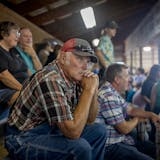A University of Minnesota study of COVID-19 in grocery store workers could help solve vexing questions about the true spread of the infectious disease and guide state strategies to slow it down before the vaccine is broadly available.
Public health Prof. Craig Hedberg is recruiting 1,000 grocers from across Minnesota to mail self-collected blood samples to see if they contain antibodies in response to the coronavirus that causes COVID-19. Patterns in the positive results by worker type and geographic location will offer important clues, he said.
"Understanding patterns of community spread and understanding what prevention measures seem to be effective at helping to limit that spread are going to remain important for the next months and probably the next couple years," Hedberg said.
The Minnesota Department of Health on Thursday reported 83 more COVID-19 deaths and 2,775 infections, bringing state totals to 4,658 deaths and 389,171 infections, but health officials believe that is an undercount due to the people who never sought testing because their infections produced no symptoms.
At least 15% of Minnesotans have probably been infected when including those who haven't been tested, and that number is probably 20% in some regions, said Michael Osterholm, director of the U's Center for Infectious Disease Research and Policy.
"Just look at the ongoing transmission that occurred over the course of the last month," he said.
If correct, that means 800,000 to 1.2 million Minnesotans have been infected.
Preliminary results of antibody testing during the Thanksgiving week of nearly 500 Twin Cities health care workers found a positivity rate of only 8.5%, said Ryan Demmer, an epidemiology researcher at the U School of Public Health.


